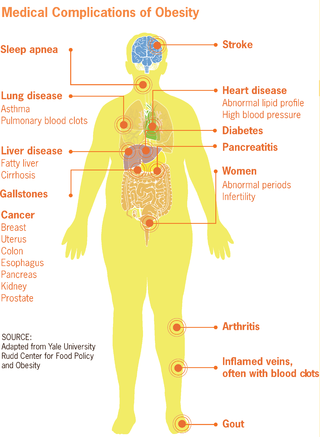
Body mass index (BMI) is a value derived from the mass (weight) and height of a person. The BMI is defined as the body mass divided by the square of the body height, and is expressed in units of kg/m2, resulting from mass in kilograms (kg) and height in metres (m).

Obesity is a medical condition, sometimes considered a disease, in which excess body fat has accumulated to such an extent that it can potentially have negative effects on health. People are classified as obese when their body mass index (BMI)—a person's weight divided by the square of the person's height—is over 30 kg/m2; the range 25–30 kg/m2 is defined as overweight. Some East Asian countries use lower values to calculate obesity. Obesity is a major cause of disability and is correlated with various diseases and conditions, particularly cardiovascular diseases, type 2 diabetes, obstructive sleep apnea, certain types of cancer, and osteoarthritis.

Weight gain is an increase in body weight. This can involve an increase in muscle mass, fat deposits, excess fluids such as water or other factors. Weight gain can be a symptom of a serious medical condition.
Fat fetishism or adipophilia is a sexual attraction directed towards overweight or obese people due primarily to their weight and size.
The National Association to Advance Fat Acceptance (NAAFA) is a non-profit, fat acceptance organization in the United States dedicated to improving the quality of life for fat people. NAAFA works to eliminate discrimination based on body size and provide fat people with the tools for self-empowerment through public education, advocacy, and member support.

"Big Beautiful Woman" is a positive (non-pejorative) term for an overweight woman.
Health at Every Size (HAES) is a public health framework that emphasizes all bodies have the right to seek out health, regardless of size, without bias, and reduce stigma towards people who are in larger bodies. Proponents argue that traditional interventions focused on weight loss, such as dieting, do not reliably produce positive health outcomes, and that health is a result of lifestyle behaviors that can be performed independently of body weight. However, many criticize the approach and argue that weight loss should sometimes be an explicit goal of healthcare interventions, because of the negative health outcomes associated with obesity.

Fat feminism, often associated with "body-positivity", is a social movement that incorporates feminist themes of equality, social justice, and cultural analysis based on the weight of a woman. This branch of feminism intersects misogyny and sexism with anti-fat bias. Fat feminists advocate body-positive acceptance for all bodies, regardless of their weight, as well as eliminating biases experienced directly or indirectly by fat people. Fat feminists originated during third-wave feminism and is aligned with the fat acceptance movement. A significant portion of body positivity in the third-wave focused on embracing and reclaiming femininity, such as wearing makeup and high heels, even though the second-wave fought against these things. Contemporary western fat feminism works to dismantle oppressive power structures which disproportionately affect working class poor people or poor people generally. It covers a wide range of topics such as diet culture, fat-phobia, representation in media, ableism, and employment discrimination.
Sizeism or size discrimination is unjust or prejudicial treatment directed at people based on their size.

Being overweight is having more body fat than is optimally healthy. Being overweight is especially common where food supplies are plentiful and lifestyles are sedentary.

Obesity is a risk factor for many chronic physical and mental illnesses.
Social stigma of obesity is broadly defined as bias or discriminatory behaviors targeted at overweight and obese individuals because of their weight and a high body fat percentage. Such social stigmas can span one's entire life, as long as excess weight is present, starting from a young age and lasting into adulthood. Studies also indicate overweight and obese individuals experience higher levels of stigma compared to other people.

Obesity and the environment aims to look at the different environmental factors that researchers worldwide have determined cause and perpetuate obesity. Obesity is a condition in which a person's weight is higher than what is considered healthy for their height, and is the leading cause of preventable death worldwide. Obesity can result from several factors such as poor nutritional choices, overeating, genetics, culture, and metabolism. Many diseases and health complications are associated with obesity. Worldwide, the rates of obesity have nearly tripled since 1975, leading health professionals to label the condition as a modern epidemic in most parts of the world. Current worldwide population estimates of obese adults are near 13%; overweight adults total approximately 39%.
Obesity is defined as an abnormal accumulation of body fat, usually 20% or more over an individual's ideal body weight. This is often described as a body mass index (BMI) over 30. However, BMI does not account for whether the excess weight is fat or muscle, and is not a measure of body composition. For most people, however, BMI is an indication used worldwide to estimate nutritional status. Obesity is usually the result of consuming more calories than the body needs and not expending that energy by doing exercise. There are genetic causes and hormonal disorders that cause people to gain significant amounts of weight but this is rare. People in the obese category are much more likely to suffer from fertility problems than people of normal healthy weight.

Caitlin Clare "Cat" Pausé was an American academic specialising in fat studies and a fat activist. From 2008 until her death in 2022 she was a senior lecturer at Massey University in New Zealand.

Body positivity is a social movement that promotes a positive view of all bodies, regardless of size, shape, skin tone, gender, and physical abilities. Proponents focus on the appreciation of the functionality and health of the human body, instead of its physiological appearance.
The social stigma of obesity, can be defined as the systemic oppression of and discrimination against people who may be considered overweight, obese, or fat. Fatphobia exists in many forms and presents itself in both institutional and interpersonal circumstances. According to numerous academics, fatphobia or general anti-fat bias is common and pervasive. Fatphobia negatively impacts the attitudes and behaviours of individuals towards those considered to be overweight or obese. Employment, relationships, and medical care are some facets of daily living that are all known to be negatively impacted by fat-phobic rhetoric or anti-fat assumptions. Fatphobia is produced and spread in many ways, including through advertising and popular media such as television shows. According to a number of scholars, television shows in North America both underrepresent and misrepresent fat people which (re)produces fatphobic rhetoric
An anti-fatphobia organization is an organization that works to address the social stigma of obesity. Anti-fatphobia organizations typically define themselves by their desire to end fatphobia in whichever contexts they focus on. Anti-fatphobia organizations in the United States are closely tied to the fat acceptance movement with anti-fatphobia activism in general, which begun around the 1960s. The fat acceptance movement can be described as a movement which centres fat people in order to address the oppression they face in society for being fat. The fat acceptance movement calls for societal recognition of a need for systemic change. Anti-fatphobia organizations often take an intersectional approach, and address how fatness is experienced at varying intersections of identity. In the United States, there are two main anti-fatphobia organizations. These organizations are NOLOSE, or the National Organization of Lesbians of Every Size, and NAAFA, or the National Association to Advance Fat Acceptance.

Being overweight or obese has influence on the sexuality of people in various different aspects. It can include negative aspects such as stigmatization which can be an obstacle for romantic developments, sexual dysfunction and an increased chance of risky sexual behavior. It can also have positive aspects in the form of fat fetishism.
Judy Freespirit (1936–2010) was a 20th century American feminist and activist, best known for her role in the Fat Liberation Movement and the LGBTQ and Disability Rights Movements. She was one of the founders of the Fat Underground, a fat feminist group, and she was a proponent of the Radical Therapy Movement. In addition, she wrote many books about the fight for social change for fat women and LGBTQ women. As a part of the Fat Underground, she wrote the "Fat Liberation Manifesto," demanding rights and social change for fat women.












